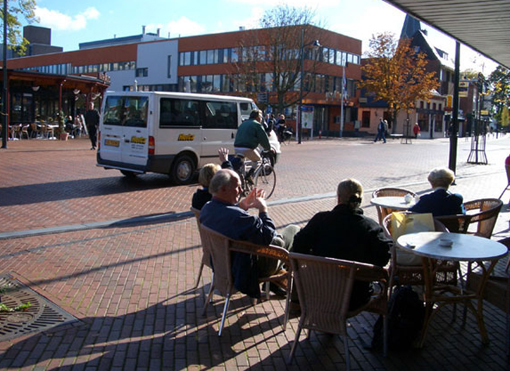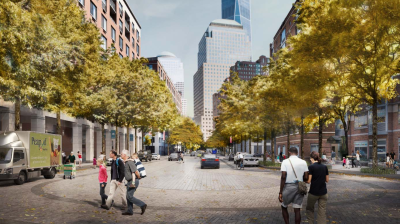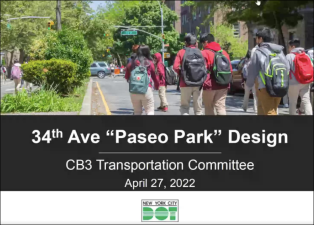Battery Park City: An Opportunity for Innovative Street Design

A "woonerf" or "shared space" street design in the Dutch town of Haren.
Yesterday a Streetsblog reader reported that the Department of Transportation is removing stop signs and installing traffic signals at some intersections in Battery Park City as a way "to provide for the safest streets possible citywide." The reader noted, "The area is home to many small children and seniors, who are
fighting the DOT change. My instinct is to agree, but I also know that
some new thinking favors fewer traffic controls."
Andy Wiley-Schwartz, vice president and director of Project for Public Spaces’ transportation program, wrote a great response in the comments section, suggesting that to create safer and more community-friendly streets, city government and community groups need to look beyond stop signs and traffic signals. Here is what he wrote:
It’s good that DOT spoke with the residents of Battery Park City and listened to their concerns. What I wonder is if either side ever considered that the streets should be designed to support a variety of types of activity, and that the pedestrian issues could in fact be far more important than the mobility issue for motorists.
In this case, we have a large park and lots of apartments, with a road in-between. So is the goal of this street to move cars through, or to facilitate community activity? If a neighborhood wants people to go slowly and respect pedestrians than there are lots of ways to change the street to get that kind of behavior, through lane widths, medians, sidewalk activity, pavement treatments, etc. Changing or eliminating controls at intersections is only a small part of that equation.

In Battery Park City, with it’s limited through-traffic and local
destinations, you have a good place to try out more innovative
treatments. Considering that we are talking about a street that is in between a large park and a bunch of houses, this would seem to be a great opportunity to traffic-calm through a variety of measures.Design speed on a street like this should be incredibly slow, but here the city and BPCA are only considering changing the intersections to control driver behavior. If people are speeding in between intersections, than the street should be redesigned to move cars very slowly all along. Then the "confusion" at the stop-controlled intersections would not be a problem.
In fact, engineers in Europe are telling us that this confusion is exactly what heightens safety, because drivers and pedestrians have to negotiate with each other. Signals increase predictability through and makes drivers and pedestrians LESS conscious that they need to be looking out for each other at all.
Haren photo: Ben Hamilton-Baillie, Woonerf diagram: Eran Ben-Joseph

